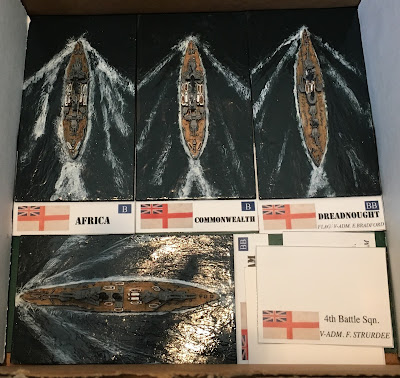I used the opportunity presented by an upcoming game of AH Jutland to do a photoshoot of my 1/2400 fleet so far. The battle cloth is by Monday Knight Productions. We found the hex pattern useful when moving the cardboard Jutland counters. It made a useful backdrop for my miniatures fleet, though this is not from an actual game.
Friday, August 19, 2016
Monday, August 15, 2016
Jutland: continued
Friday, August 5, 2016
Jutland 1916: GHQ 1/2400
Continuing the Jutland theme, I have recently been painting some of the excellent GHQ Micronauts Great War range, 1914-18. Although they are very small, at a scale of 1/2400, the detail on these models is amazing. For example, the teak decks are modeled, in great detail, along with numerous deck fixtures, the superstructure and some masts. Not all of the masts can be cast at this scale. However, Harmon and I have found that very thin gauge music wire can be used to scratch build masts. I have only tried so far to build the very tall main mast for HMS Iron Duke, the flagship of the Grand Fleet in 1916.
I'll take some photos of the individual ships soon. However, I just wanted to share what I have painted in the last 6 weeks. I highly recommend this range. GHQ has a great website and provides excellent service and support for all of its numerous ranges. Until now, I had not discovered GHQ. My loss! They are a treasure.
I must immediately give full credit to the excellent article written by the author of the "Black Powder Games" Blog on painting GHQ models. It provided the inspiration and all of the techniques, which I tried to incorporate in my own humble efforts, though you will see much better work at his site:
So here we go. The Grand Fleet 1916...part one.
 |
| The Grand Fleet so far |
I used Litko flexible metal base bottoms attached to the Litko wooden bases to allow me to store these delicate models in boxes with magnetic sheet inside. Please click to enlarge the pictures.
 |
| Work in Process! |
After much experimentation, I have learned the following lessons:
1. The models have to be cleaned and filed very, very carefully. What looks to be "detail" is often metal residue. It tends to coil up, looking like a deck fitting!
2. The fit of the deck infrastructure sometimes needs some adjustment. For example, the gun turrets don't always clear deck structures, etc.
3. The gun barrels are very, very soft, easily bent and difficult to straighten. Likewise the tripod gunnery observation masts. Handle with great care.
4. The detail is so fine, you have few opportunities to touch up the paint. You need very thin coats of paint and overpainting is seldom satisfactory. Don't put anything on the hull/deck until it is painted and detailed.
5. The more detail I try to add, the more "gummed-up" the model looks.
6. Don't be tempted to add piano wire masts or rigging unless you are an experienced modeler. It is possible, but drilling out the soft metal is a very tricky. I caused a lot of damage trying to install some simple flag staffs.
These models are beautifully detailed. However, the soft lead alloy is easy to damage.
 |
| HMS Iron Duke with mast and rudimentary rigging |
The ocean bases are simply thin Litkos with several layers of white glue, paint and lots of varnish. The labels were produced in Photoshop using Black Powder Games labels as the model to follow.
Noble Knight is a very good source for these models and also has excellent service.
Noble Knight is a very good source for these models and also has excellent service.
Subscribe to:
Posts (Atom)

















